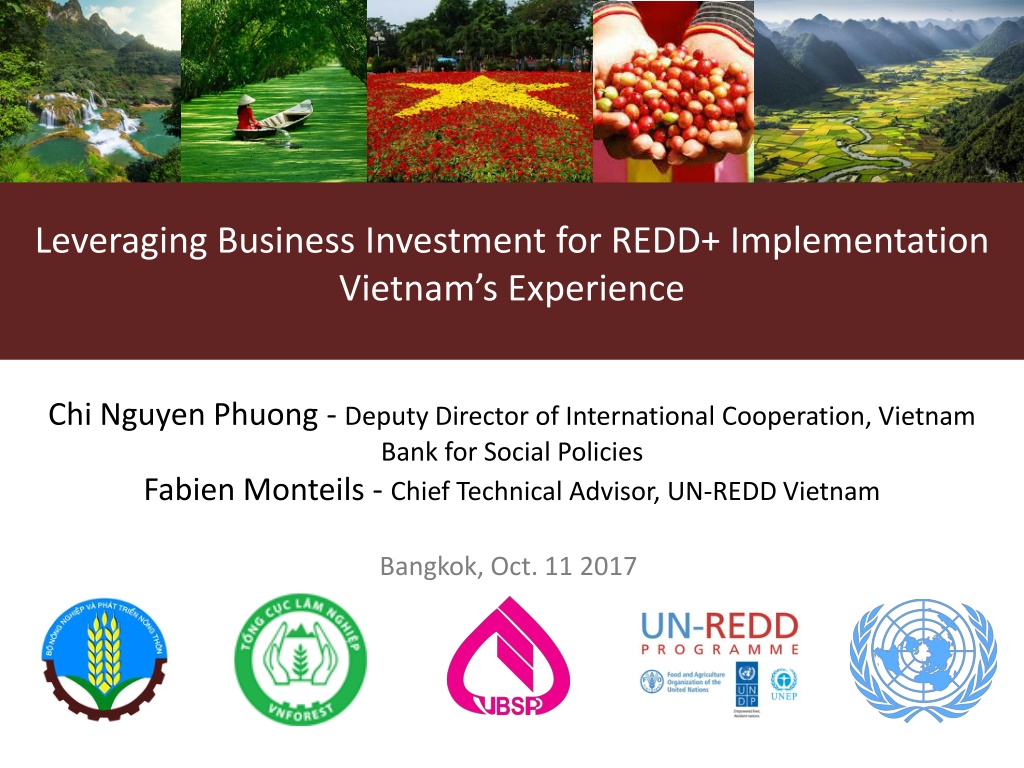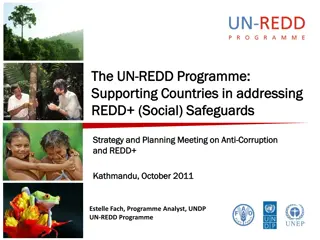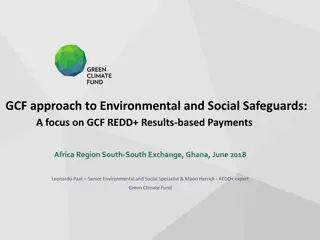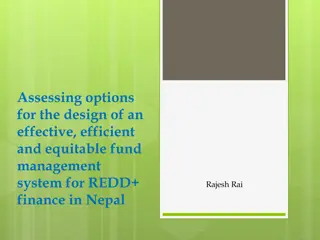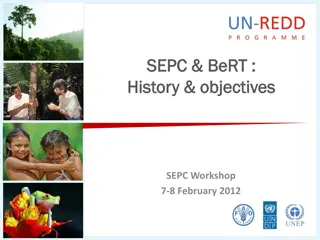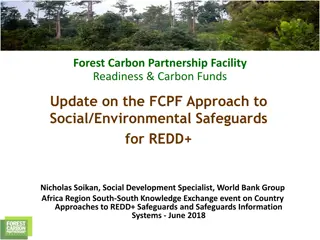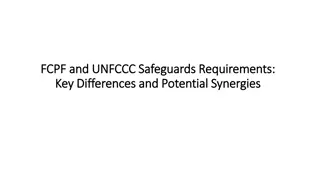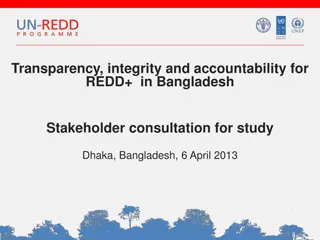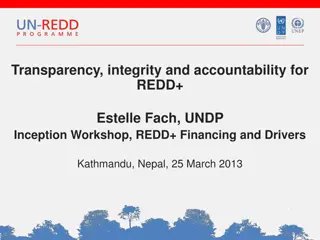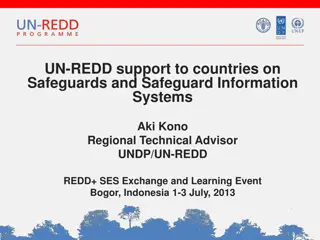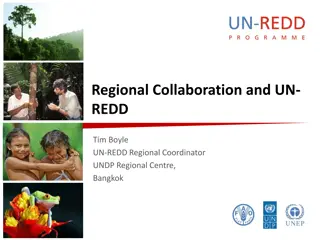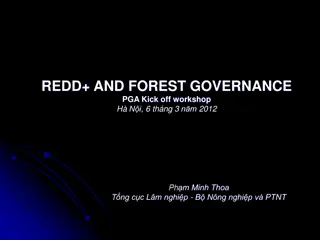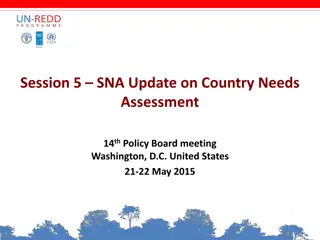Promoting Sustainable Agricultural Practices for REDD+ Implementation in Vietnam
This presentation discusses the experience of Vietnam in leveraging business investment for REDD+ implementation. It highlights priority areas and pilot projects in agriculture commodities, plantations, timber industry, and natural forest goods and services. The focus is on integrating commodity-REDD+ action plans, supporting sustainable models, promoting producer organization, and enhancing financial services across different sectors to drive sustainable development.
Download Presentation

Please find below an Image/Link to download the presentation.
The content on the website is provided AS IS for your information and personal use only. It may not be sold, licensed, or shared on other websites without obtaining consent from the author. Download presentation by click this link. If you encounter any issues during the download, it is possible that the publisher has removed the file from their server.
E N D
Presentation Transcript
Leveraging Business Investment for REDD+ Implementation Vietnam s Experience Chi Nguyen Phuong - Deputy Director of International Cooperation, Vietnam Bank for Social Policies Fabien Monteils - Chief Technical Advisor, UN-REDD Vietnam Bangkok, Oct. 11 2017
Set priority areas and pilots Integrated commodity- REDD+ action plans National REDD+ Action Programme Agriculture commodities - Support and establish commodity forums - Pilot and replicate sustainable models - Support producers organization Plantations and timber industry - Support research on long-rotation models - Pilot and replicate, develop guidelines, incentivize - Support access to assistance and certification Natural forests goods and services - Monitor, assess and develop business models - Pilot cooperation and integration of supply chains 1 Rubber (VRA, VRG ) Aquaculture pilots V. Cashew Association 2 Cost benefit analysis Forest certification CBFM 3 Expert group/ forum VietRap Financial services - Cross-cutting to the three sectors above: design adapted financial mechanisms (directly with financial sector, or by promoting adequate legislation) Fargreen/ICRAF 4 ITDR (tourism) Collaboration with PFES
Illustration from the coffee sector I. Identifying and piloting sustainable models 1.1 Technical and financial assessment of existing sustainable models 1.2 Development of technical guidelines for best practices (and test with stakeholders) 1.3 Identification of potential area for pilot activities, sites, partners, beneficiaries, and deployment of pilot sustainable models (capacity building, support and monitoring evaluation) Facilitate dialogue and coordination (VCCB), integrated planning (Sust. Coffee 2020 ) Collaborate with other sectors to leverage potential synergies (ex. Cashew) Collaborate with business association to integrate agroforestry in training manuals/campaigns Implementing demonstration farms (Nestle )
Item Monoculture coffee Coffee- durain Coffee- avocado Coffee-Cassia siamea 2,459,293 2,636,388 459,280 459,280 2,000,013 2,177,108 7,777 9,622 30,000 30,000 Inputs Investment costs Production costs Seedlings Land preparation Digging holes. planting trees Additional breeding trees Lime Organic fertilizer Chemical Fertilizer Herbicide Fuel Labors for crop management Outputs Income from coffee Income from coffee residue Income from durain Income from avocado Income from peppers Income from Cassia Income from Cassia residue Shadow price from carbon stock Profits NPV IRR BC Ratio 2,617,923 459,280 2,158,643 11,277 30,000 2,879,997 459,280 2,420,717 11,143 30,000 22,220 778 35,000 470,303 403,931 30 ,000 201,500 24,680 853 38,875 510,131 444,473 47,550 201,500 24,220 953 38,125 502,703 438,911 47,550 201,500 25,580 838 35,000 589,671 444,231 30,000 201,500 798,504 2,034,838 1,984,000 869,424 9,680,522 3,616,000 863,404 17,247,064 3,616,000 1,052,754 6,195,505 3,780,000 33,075 33,075 5,980,875 33,075 33,075 13,575,000 2,002,770 306,000 1,200 17,263 3,830,338 3,780,000 23.5% 50,572 7,044,134 2,577.557 36% 22,989 72,460 3,315,508 1,220.476 31% 14,629,141 6,319,298 76% 5.84 1.43 2.96 1.87
Illustration from the coffee sector II. Traceability systems development 2.1 Assessment of existing/past initiatives on traceability and existing standards 2.2 Analysis of supply chains (actors and association/ cooperation models) and recommendations for piloting 2.3 Identification of potential area for pilot activities, sites, partners, beneficiaries, and deployment of pilot traceability models (capacity building, support and monitoring evaluation) 2.4 Develop guidelines for traceability Develop information system (with GCP ) Encourage broad stakeholders engagement on real-time monitoring pilots (Di Linh) Collect experience directly from individual private companies (ACOM)
Illustration from the coffee sector Exploit existing laws and regulations (40.000ha reallocation) III. Monitor and control the evolution of coffee surface 3.1 Strengthen systems to monitor surface and expansion of coffee surface, including spatial monitoring using satellites and other relevant technologies 3.2 Control that evolution of coffee surface complies with official targets 3.3 Support conversion of coffee land back to forest where relevant or required by law IV. Financial mechanism development 4.1 Review and evaluation of existing incentives for sustainable coffee vs market trends 4.2 Develop proposal for financial incentives relevant for sustainable models identified (green credit, subsidies, premium price with buyers, taxes exoneration, PES, etc.) 4.3 Conduct extensive consultation process to set up partnerships to pilot financial mechanism 4.4 Pilot mechanism with stakeholders identified in component 1 and 2 (Capacity building, support and monitoring evaluation) 4.5 Develop guidelines Connect with integrated land use planning initiatives and dialogue platform Review and monitor enterprises plans for activities and investments Pilot joint implementation of REDD+ allocation and PES Coffee Development Fund?
Focus on the financial sector in Vietnam Fast credit expansion to support economic growth (>15%/year) Low access to financial services (21% adult pop. In 2013) Overall under-capitalized + fast expansion: little appetite for new markets and constraints for sustainability Green finance estimated about 1% (SBV) Recent policies to implement relevant plans (Paris Agreement, Green Growth ) 03/2015: Directive 03/CT-NHNN from SBV: Requests credit institutions to promote green credits and social and environmental risk management in credit supply. Voluntary basis, mandatory report. 09/2015: Decree No. 55/2015 /ND-CP: Reduces reserve ratios obligations of financial institutions for medium-size credits to agriculture and rural development 12/2016: Circular 39/2016/TT-NHNN: Requests lending transactions conformity with regulations and relevant laws, including the legislation on environmental protection But yet no mention of green banking and related instruments in the Law of Credit Institutions
Focus on the financial sector in Vietnam Illustrations/initiatives: $240M Green credit line from SBV for financial institutions lending to SME (based on JICA grant); $100M similar in discussion with KfW on renewable energy Green bond market being established. First green bonds expected In 2018 (HCMC and Ba Ria Vu Tau) Guidelines developed to assess social and environmental risks in 10 sectors (SBV/IFC) Launch of Vietnam Sustainability Index (20 companies in HCMC stock exchange) Support to relevant credits (concessional ) from VBSP, Agribank ) Provisions from the NRIP (draft, in progress): 1. Develop and implement a green credit scheme for REDD+ activities 2. Improve deforestation and forest degradation risk assessment in financial institutions credit analysis systems and pilot implementation 3. Strategic dialogue and capacity-building activities on private and financial sectors engagement and green credit for REDD+
Illustration from the Bank for Social Policies Profile: VBSP: public not-for-profit policy bank 1stmicrofinance institution in Vietnam (7M household clients) Assets: $8 billion; Outstanding loan: $7 billion 28M individual loans to individuals and business/producers Contribution to massive social progress (country s poverty rate: 20% in 2004, 4.5% in 2015) Serving poor, near-poor and vulnerable people, ethnic minorities Assets: local network, local governance arrangement, and specialized approach to understand and serve a risky market From 63 provinces branches down to 200.000 points of service at village/hamlet level 21 credit schemes for targeted groups Risk-management system based on collaboration with local mass organizations and people s committees (peer control), procedure disclosure Non-performing loan rate: 0.87%
Illustration from the Bank for Social Policies Forest rehabilitation & sustainable forest management - KfW6 Approx. $3.5M (grant) Approach: Diversifying forest products to stabilize income Method: Transfer $200/250 to farming households and rural communities through deposit accounts; Result-based withdrawal upon verification Impact: >14.600 beneficiaries/accounts created; Forest restoration and sustainable management of 32.700ha Forest Sector Development Project - WB >$38M loan (revolving fund) 2005-2034 Approach: Switch from subsidizing plantations to lending to small- holders; Forest-based socio-economic improvement, poverty reduction, job creation, food security and fight against climate change Method: Provide loan directly to borrowers. Loan from 1 to 15 years. Current interest rate at 6.6%. No required guarantee for households (<$2.200) Impact: 76.500ha conserved special use forests and sustainably managed plantation forests. Current portfolio: $21M Accounted for in Vietnam ER-Programme to FCPF Carbon Fund ($23M)
